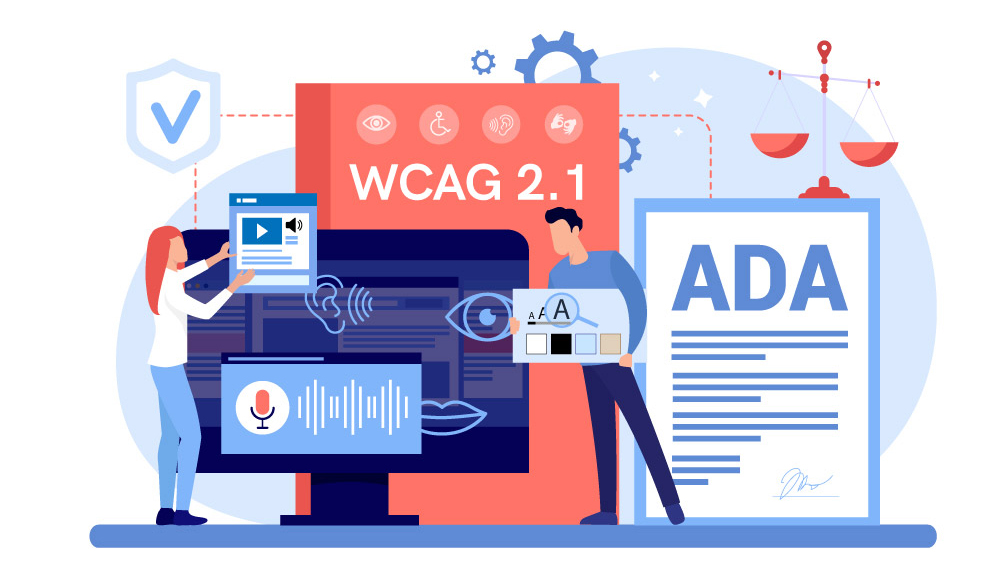
We've talked about this topic in at least one previous post, but it's such an important and relevant issue, we wanted to circle back! First, let's answer the most important question:
What is ADA/WCAG Compliance?
The Americans with Disabilities Act (ADA) is a civil rights law that prohibits discrimination against people with disabilities in all areas of public life, including jobs, schools, transportation, and all places that are open to the general public.
In the context of ecommerce, ADA compliance means that online businesses must ensure that their websites are accessible to people with disabilities, including those who are blind or visually impaired, deaf or hard of hearing, and those with physical or cognitive disabilities.
Web Content Accessibility Guidelines (WCAG) are a set of guidelines developed by the World Wide Web Consortium (W3C) to help website owners and developers make their sites accessible to people with disabilities. WCAG guidelines are organized into three levels of accessibility: A, AA, and AAA, with AA being the most widely accepted standard.
Why is ADA/WCAG Compliance important for ecommerce?
First and foremost, ADA/WCAG compliance is the right thing to do. People with disabilities have the same right to access and use websites as anyone else. By making your ecommerce website accessible, you're creating a level playing field for all customers.
Secondly, there's a legal requirement for businesses to comply with ADA. In recent years, there has been a surge in lawsuits filed against ecommerce websites that are not ADA compliant. Large ecommerce brands like Target, Nike, and Beyoncé's Parkwood Entertainment have all been sued for non-compliance.
For example, in 2019, Beyoncé's Parkwood Entertainment was sued by a visually impaired fan who claimed that the singer's website was not accessible to blind people. Similarly, in 2017, Target was sued by a blind customer who claimed that the retailer's website was not accessible.
These lawsuits can be costly for businesses. In some cases, businesses have had to pay significant settlements or have been forced to redesign their websites to comply with ADA standards.
How can ecommerce businesses achieve and maintain ADA/WCAG compliance?
Achieving ADA/WCAG compliance requires ongoing effort and a commitment to accessibility. The following are just a few steps that ecommerce businesses can take to achieve and maintain compliance:
-
Conduct an accessibility audit: Start by conducting an accessibility audit of your website. There are several free online tools available that can help you identify accessibility issues on your site. They are easy and fast to install and use.
-
Make necessary changes: Once you've identified accessibility issues on your site, work to make any changes necessary to bring your site into compliance with ADA/WCAG guidelines. There are lots of great examples out there of what works and what doesn't and what is and isn't acceptable under the guidelines.
-
Train your team: Ensure that your team is trained on ADA/WCAG compliance and the importance of accessibility. The "why" is just as important (if not more) as the "how."
-
Test your site regularly: Regularly test your site for accessibility issues to ensure that it remains compliant with ADA/WCAG guidelines. It takes just a few moments to run the audit tool, for example on a monthly basis, to make sure your site continually remains in compliance.
-
Work with an accessibility partner: Consider working with an accessibility partner to help you achieve and maintain compliance with ADA/WCAG guidelines.
Ultimately, prioritizing ADA/WCAG compliance is essential for ecommerce websites to ensure that all customers, including those with disabilities, can access and use their services. By taking proactive steps to achieve and maintain compliance, ecommerce businesses can not only avoid legal issues but also demonstrate their commitment to inclusivity and accessibility. Let's work together to make the web a more accessible and welcoming place for all!

